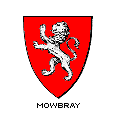
office (215)
233-4988
fax (000) 000-0000
Alt # (215) 000-0000
Brookfield Ancestor Project - Surety Barons
Magna Charta Baron Page
for
William De Mowbray
Lord of Axholme Castle, Lincolnshire

Return to Barons at Runnymede Page
WURTS’ MAGNA CHARTA provided a brief accounting of the feudal headquarters of some of the Magna Charta Barons. Some of the castles have been badly damaged. Some have disappeared entirely. Often we can learn of them through Medieval and Renaissance accounts, and some of them require the discerning eye of the archeologist. Others await the evidence brought out with a shovel and pick, by the trained archeological historian.
A portion of the information concerning Surety Baron WILLIAM de MOWBRAY is as follows:
WILLIAM de MOWBRAY, the Surety, came of age in 1194/5. He was early embittered against King John by being compelled to surrender the Barony of Frontboeuf, which Henry I had conferred upon his great grandfather, Sir Nigel d'Aubigny. That, and the aid exacted from his vassals, enraged him. We note in Magna Charta, Article 16, that a lord is forbidden to demand more service than a fief owes. Perhaps William was influential in getting this clause accepted. The debt was probably exacted because Mowbray, upon the accession of King John, was tardy in pledging his allegiance and at length swore fealty only on condition that "the King should render to every man his right." At the breaking out of the Baronial war, he was governor of York Castle, and it is not surprising that he at once sided with the Barons against King John, and was one of the most forward among them.
He was a party to the "Covenant for holding the City and Tower of London," and one of those whom the Pope excommunicated. He continued in arms after the death of King John, and in the Battle of Lincoln he was taken prisoner. His lands were confiscated and bestowed upon William Marshall, Jr., the Surety, but he was subsequently allowed to redeem them. After this he attached himself to King Henry III. He died in 1223/4 at his Castle in the Isle of Axholme, and was buried in the Abbey of Newburgh in Yorkshire. His wife was Avice d'Albini.
The Mowbray Castles are an impressive array. Axholme seems to offer no discernible ruins, and the land has become a swamp. New-Castle-upon-Tyne boasts a stern building in dreary surroundings, built on the site of an earlier fortress, and thus its present name. It has more the appearance of a prison than a Royal stronghold, partly because its walls are begrimed with factory smoke. However, if it had been left out in the country, it might have fallen into ruins sooner. It is an exceptionally fine example of a Norman stronghold.
The keep is the chief relic of the Castle on the Tyne. For centuries it was the residence of Royalty when Kings visited the North. It symbolized their power at those times when they were not in residence. It was founded by Robert, son of the Conqueror. It had massive walls and was flanked by a moat on the town side, while the steep climb discouraged approach from the River. The present keep is a later building, dated in the last decade of the 12th Century. Only once did William the Conqueror stop here. At the end of the Century Robert de Mowbray, Earl of Northumberland, seized and garrisoned it in his effort to dethrone William Rufus. At the death of Henry I it was captured by King David of Scotland. Stephen arrived with an army, and a truce was arranged, whereby King Stephen agreed to cede Northumberland to the Scottish Kings who, from then on, held court at Newcastle.
The Castle was founded in the 11th Century by Robert Curthose, but the keep, which is all that is left, dates from about 1172. It is eighty-five feet high; to the top of the turret it measures one hundred seven feet, and its walls are from twelve to eighteen feet thick. The second floor is reached by an outside staircase. The chapel, the finest room, is located in the basement. Both the Great Hall and the Well Chamber have been well preserved.
Originally Newcastle was the strongest fortress in the North. Before its completion William the Lion was marched through its gates, after the capture of Alnwick and Baliol 26 December 1262, and did homage to Edward I as King of Scotland, in Newcastle's Great Hall.
The area within the outer walls and fosse measured three acres. Fragments of the wall, the Black Gate, the principal entrance, stand encased in late construction. The Watergate or Southern Postern has disappeared entirely. The keep is well preserved and the chapel also, a fine example of late Norman style.
William the Conqueror built two Castles at York. His second Castle is now marked by Baile Hill; the mound of the Castle is nonexistent. Clifford's Tower marks the place of the keep of the former Castle, near which in 1188/9 five hundred Jews were massacred in the reign of Richard I.
Appreciation is expressed to Reed M. W. Wurts, one of the Heralds of the Society for furnishing the Baron’s Shield on this page.
Return to Barons at Runnymede Page